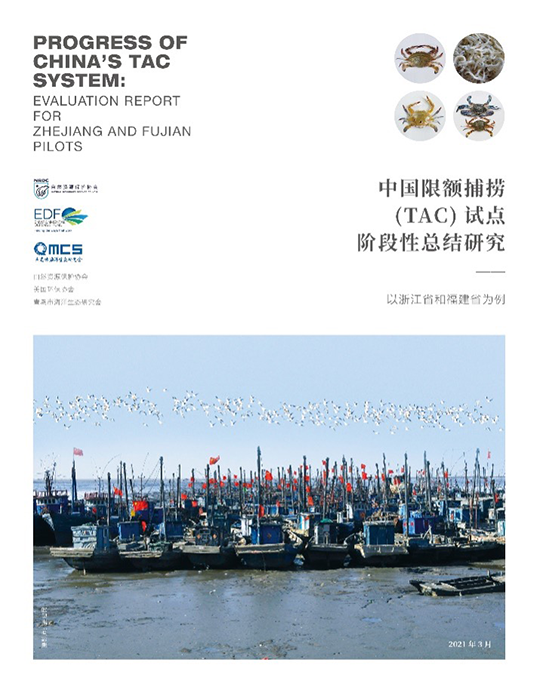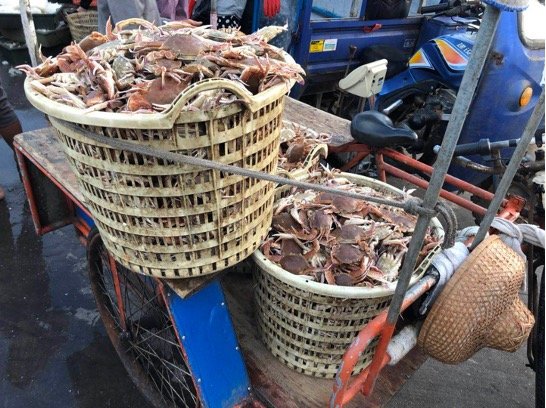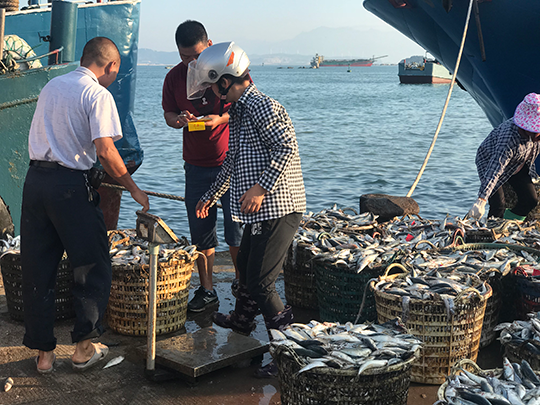NRDC与美国环保协会(EDF)、青岛市海洋生态研究会(QMCS)等单位合作,以浙江省和福建省的试点为研究对象,完成并发布了《中国限额捕捞(TAC)试点阶段性总结研究报告——以浙江省和福建省为例》(简称TAC报告)。建立渔获物产出控制制度,是提升我国海洋渔业管理能力、实现海洋渔业可持续发展的必经之路,但目前面临多种挑战。限额捕捞制度(TAC)是渔获物产出控制的核心。我国从2017年开始在沿海省份进行TAC试点。本文以TAC报告为基础介绍了TAC试点的背景,总结了浙江和福建试点取得的成果和面临的挑战,并对试点在全国铺开以及相关政策的推进提出了建议。
 TAC报告 @NRDC
TAC报告 @NRDC
我国拥有漫长的海岸线和庞大的海洋捕捞船队,海洋渔业产量居世界第一位。长期以来,我国政府高度重视海洋渔业资源的养护和可持续利用,实施了海洋捕捞许可、禁渔区和禁渔期等管理制度,采取了捕捞渔民转产转业等管理措施。然而,渔业资源利用和管理方式粗放的问题仍有待改善,捕捞能力超过渔业资源的可承受能力,渔业资源管理需进一步加强。
TAC试点的背景
"十三五"期间,在加快生态文明体制改革的背景下,我国渔业“生态优先、绿色发展”的发展理念首次被提出,给海洋渔业资源的养护和可持续利用也提出了更高的要求。由于我国海洋渔业管理长期依靠的捕捞渔船数量和主机功率“双控”等投入控制制度和禁渔区、禁渔期、最小网目尺寸等技术性措施尚无法扭转资源衰退的趋势,补齐产出控制这块“短板”便成为新时期海洋渔业资源管理制度改革的重点。根据现行《渔业法》,我国的产出控制以限额捕捞(TAC)制度为核心。
 几种渔业资源管理方法以及它们之间的联系 @Japan Fisheries Agency
几种渔业资源管理方法以及它们之间的联系 @Japan Fisheries Agency
TAC制度作为一种精细化、科学化和现代化的渔业管理制度,要求围绕种群资源建立系统性的管理体系。该管理体系包含多个要素,如为了维持长期可持续的最大渔获量,限额需基于种群评估,考虑特定鱼种的寿命、群体结构、性别比例等生态学特征, 遵循经同行审议过的科学建议。设定后的执行需要根据该渔业的管理目标和特点等选择配套的投入或技术措施组合。此外,该体系还要求有可靠的渔获物监测体系来监督配额实施和收集用于种群评估的关键信息。管理部门需控制捕捞能力,以尽可能实现其与可捕量的平衡,避免因捕捞能力过剩导致渔民收入过低。这些都对制度能力和管理成本都提出了较高的要求。
我国沿海省份从2017年开始进行特定渔种的TAC试点。截至2020年底,全国已陆续开展15个试点。值得注意的是,我国传统的渔业管理模式、制度建设和管理经验在支撑TAC时,还有较大的差距,加上我国海洋渔业渔船数量多、从业人数多、渔业类型多,经营方式分散、区域间差异大等特点,要大范围实施TAC制度还存在诸多困难和挑战。因此特别需要对前期TAC试点进行总结和分析。
为此,NRDC、EDF和QMCS,联合浙江省海洋水产研究所与福建水产研究所,对浙江与福建两省三个先行试点(浙江浙北渔场定刺网梭子蟹试点、瑞安丁香鱼海上加工业试点和福建龙海多种梭子蟹试点)进行了研究。考虑到试点仍处于初步探索阶段,涉及的水域和船只都较少,短期内还无法对资源水平和渔民的经济状况产生实质性的影响。研究团队对照试点自身的目标,重点分析了渔获物监测与监督体系。
TAC试点取得的成果
研究团队认为,通过几年的试点,浙江与福建在多个TAC要素上进行了突破性的探索,切实推动了中国渔业迈向精细化、科学化和现代化之路。
缺乏有效的渔获物监测体系是目前TAC制度难以在我国落地的重要原因之一。传统使用的纸质日志和船位监测系统(VMS)不足以支撑TAC制度。基于此,三个试点均以探索渔获物监测工具以及监测体系搭建作为工作重点之一。其中,电子日志和观察员制度都是首次在国内渔业层面开展。
为了实现较为实时的监测,浙江与福建的试点都引入了电子日志,渔民可在海上通过卫星或宽带网络发回数据。对浙江省试点的分析显示,相比于传统的纸质日志,电子日志相比在许多方面具有明显的优势,包括数据显示清晰、传输及时、通过系统内置可防止不合理和不完整的报告。另外,渔民主动报告的数据在与其他来源相互验证时,电子日志可自动进行大规模、快速的比对,智能及高效地判断高风险船只,省去大量人力成本。但因设备稳定性不足、渔民对智能设备不熟悉以及缺少法律法规支持等原因,渔民对电子日志的接受度普遍低于纸质日志。
 浙江台州对填写渔捞日志支撑总量管理的宣传 @NRDC
浙江台州对填写渔捞日志支撑总量管理的宣传 @NRDC
科学观察员制度是浙江省试点引入的又一重要现代渔业管理制度。该制度在三疣梭子蟹试点中率先引入,在丁香鱼试点中进展迅速并连续实施了三年。在各种渔业捕捞生产过程监测工具中,观察员制度具有客观以及能够同时收集多种数据的优势,包括生产性数据、生物学科学数据以及渔业法规执行情况等。此外,在我国建立TAC制度的初期,观察员还可发挥独特的作用,比如帮助解决渔民在填报渔捞日志时遇到的困难,以及观察整个生产(包括海上作业、转载、上岸和加工)的过程,帮助管理人员了解渔业的具体情况,为之后改进试点的管理提供重要的信息。丁香鱼试点中还创设了全程登船的执法观察员。
监测体系的设计需要考虑渔业的特点,纳入正面激励可大大促进对管理规定的遵守。浙江丁香鱼试点便是一个为所有利益相关方提供正面激励的案例。作为伏休特许渔业,该试点渔业成立之初主管部门和该渔业合作社就设定了较高的准入条件。同时,主管部门严格遵循管理规范,违反试点规则的船只将被取消下一年的许可。而如果整体表现不佳,该专项可能被取消,这有力地提升了合作社的合规意愿。而其他试点所反映的负面激励包括,试点规定遵守程度如何对其下一年的作业没有太大影响,以及水域里同时存在其他不受TAC限制的渔具捕捞。另外,该渔业组织化程度高, 领导将试点规则转化为合作社内部的商业安排,得到了渔民的理解和接受。自我管理能与监督执法力量相互配合,使该试点在日志填报和遵规方面比其他试点都好得多。这也为其他伏休特许捕捞管理提供了借鉴。
 浙江省瑞安市试点鱼种丁香鱼的烘干制品 @NRDC
浙江省瑞安市试点鱼种丁香鱼的烘干制品 @NRDC
除了监测体系外,试点在科学设定可捕量方面也取得了进展。因为缺乏资源调查数据,三个试点在试点之初都主要根据过去几年的捕捞量制定可捕量。试点开展后,浙江和福建在信息积累方面都取得了较大的进展,包括利用考察船进行资源丰度调查和独立采样获得的数据、观察员随渔船海上采样获得的梭子蟹和副渔获物的生物学数据,以及环境因子等其他数据。例如,福建通过在码头对拥剑梭子蟹进行生物学采样获得的长度频率数据,已可用于基于长度贝叶斯生物量评估,为未来可捕量的设定和捕捞规则的制定提供了科学依据。
 福建试点中在码头对试点蟹类进行生物学采样 @福建省水产研究所
福建试点中在码头对试点蟹类进行生物学采样 @福建省水产研究所
总体而言,浙江和福建两省在借鉴渔业管理发达国家的先进经验、提升对TAC制度的认识方面积累了丰富的经验。两省科学家参与国外实地考察并组织了包括TAC国际经验、生产监测、观察员制度、渔民合作社、基于产权的管理等多个专题国际研讨会,为国内交流搭建了平台,对试点的设计和发展起到了积极的作用,也给其他省市的TAC试点提供了借鉴。试点重视并实践了各相关方包括农业农村部渔业局、省、市、县各级渔业部门、科研院所、渔业合作社和渔民等的参与,并通过工作方案的形式进行职责的分工。这种工作方案也可以看作是“渔业管理计划”的雏形。
 2017年在北京举办的限额捕捞管理国际研讨会 @EDF
2017年在北京举办的限额捕捞管理国际研讨会 @EDF
TAC试点面临的主要挑战
首先,渔捞日志是获得生产数据的最主要途径,但渔捞日志的检查尚未受到与许可证、渔具和安全设施的检查同样的重视。执法部门发现,渔捞日志填写不完整、不及时准确等问题较普遍。然而,目前的法律缺乏对此类行为的判定标准和处罚细则,国内可供参考的先例较少。另外,国内观察员制度的首要挑战是缺乏合格的人员、资金,以及观察员的法律地位不明。
其次,除了监测工具外,监测体系还涉及对所收集信息的核验以保障数据可信度,这通常是通过不同工具收集的信息相互对比进行。研究显示,转载船是监测的一大漏洞。目前对转载船的监管较为薄弱,渔民提交的转载船相关报告的比例和真实性都较低,这给渔民报告信息的核验带来很大的挑战。不过,无论是否能成功收集转载船数据,在港口对渔获物进行监测都是一个必不可少的核验数据的环节。几个试点虽然规定了定点上岸,但目前对港口的监测还有待展开。
 渔民通常在上岸的港口对渔获物进行统计和交易 @NRDC
渔民通常在上岸的港口对渔获物进行统计和交易 @NRDC
TAC涉及一系列监管理念和模式的深度转变,不能一蹴而就。推行的过程需要省和县市级机构保持持续且密切的沟通和协调,尤其是县市级机构需要获得来自省级层面积极的信号、明确的要求和足够的指导;还应通过国家政策给与财政、行政、科研,乃至公共传播与教育资源的支持。
由于我国限额制度起步较晚,预计还需要较长一段时间来创造实施条件。虽然“十四五”期间TAC总体策略尚未公布,但我们已经看到不少令人欣喜的信号。例如,今年起全国所有伏休期间的专项捕捞纳入TAC管理;渔港综合改革正在加快推进,定点上岸及渔获物可追溯试点的开展,进出港通报已经全国推开;“十四五”渔业补贴政策朝引导渔民养护资源、减船转产方向的调整等,它们都为TAC制度的实施创造了积极的条件。
改进TAC工作的建议
考虑到试点反映出的普遍性问题和挑战,研究团队为全国试点的开展和相关政策的推进提出了以下建议:
1. 开展试点评估,建立TAC制度实施的分阶段目标和路线图
总结TAC试点的经验;逐步测试并完善更多配套制度;扩大试点水域、增加生命周期更长、经济价值更高的有鳍类试点鱼种;学习与交流国内外经验;在考虑国内实际情况的基础上建立阶段性目标和制定实施路线图。
2. 科学设定总可捕捞量
建立国家级渔业资源评估体系,建立和培养专业人员,开展常规的渔业资源调查和评估;设立专项渔业资源调查资金,支持长期、定期的近海渔业资源调查;制定科学的捕捞控制规则,并随着资源的变动调整总可捕量和其他管理措施。
3. 加大对渔获量监测和统计体系建设的投资,为TAC 管理夯实数据基础
落实渔捞日志制度;推动电子报告与监测工具的开发与应用,促进实时掌握捕捞、上岸、销售和转载数据情况,建立关键基本信息的标准,汇集到国家统一数据库,便于记录、处理、比对分析、储存和分享;加快推进全国渔获物定点上岸和码头监测。
4. 建立TAC渔业管理计划
选择部分重点经济渔种乃至种群尝试建立专项渔业管理计划,以协调在各相关方之间达成一致而明确的目标;制定符合法律要求可执行的管理措施,促进鱼类种群和生境的重建和保护,并满足参与渔业的不同相关方的需求。
5. 加强法律法规建设以及监管和执法,为TAC管理提供法律保障
借助《渔业法》修订的契机,健全支撑TAC制度的法律制度体系;将生产报告作为海上和港口监督检查的优先事项之一,制定处罚细则;特别加强对转载船的监管;利用大数据及信息科技手段,增加执法效率;加强跨区域、跨部门的监督和管理。
6. 促进以TAC为核心的产出管理与传统投入管理手段的协调发展
将TAC 制度的发展与投入措施的加强如削减捕捞能力、打击IUU、网目尺寸等的细化和落实相协调,最大限度地发挥保护作用;中央政府和省级政府应为TAC 制度的完善提供持续的制度、财政和技术支持。
————————————————————
参考文献
Zhu, W., Lu, Z., Dai, Q., Lu, K., Li, Z., Zhou, Y., ... & Li, W. (2021). Transition to timely and accurate reporting: An evaluation of monitoring programs for China’s first Total Allowable Catch (TAC) pilot fishery. Marine Policy, 129, 104503.
Cochrane, K. L., & Garcia, S. M. (Eds.). (2009). A fishery manager's guidebook. John Wiley & Sons.
陈园园, & 唐议. (2012). 关于改善我国海洋渔业统计制度的建议. 海洋渔业, 34(4), 476-481.


